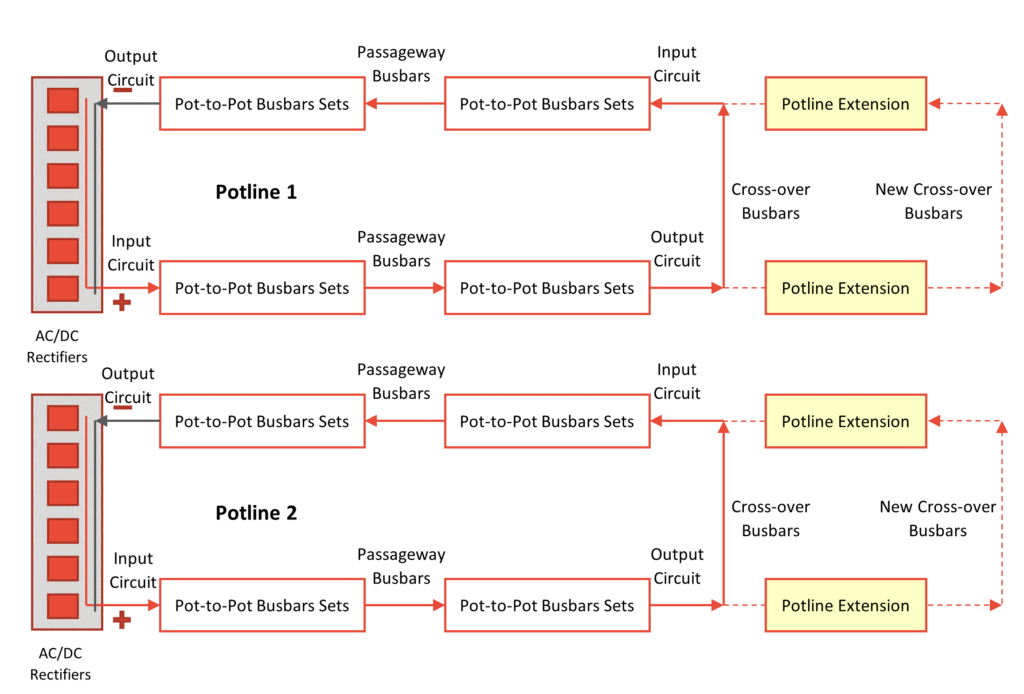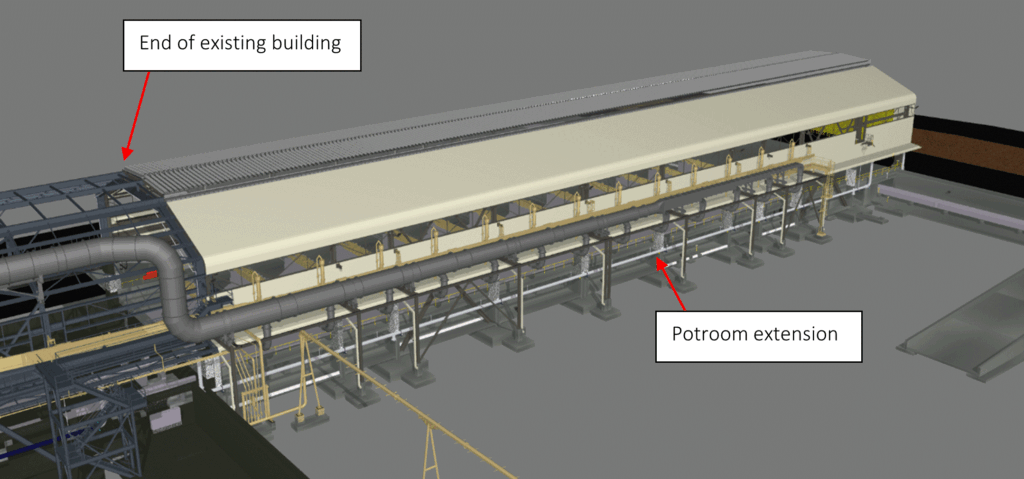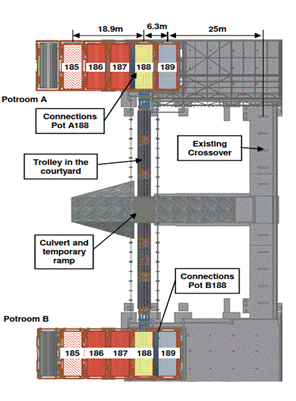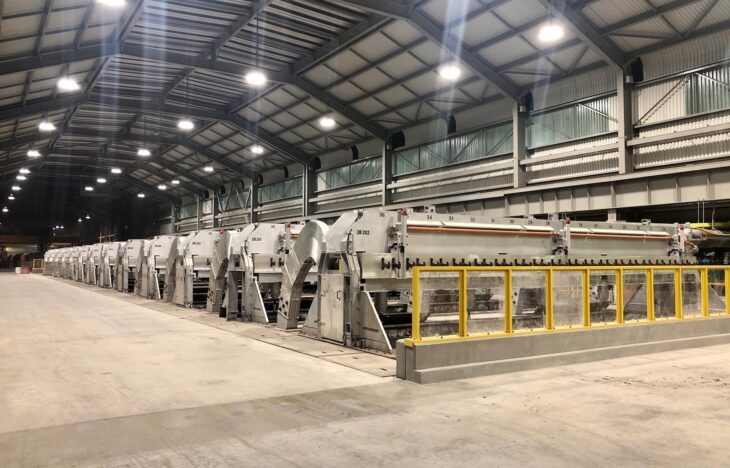By Jean-Denis Carrier, Hatch, and Saif Alhashmi, EGA.
Introduction
Regardless of the market price, the aluminum industry has continuously been working to improve its cost position by optimizing the utilization of existing assets. This push for optimization has been especially true in the challenging market conditions prevailing since the global financial crisis of 2008. The obvious path of progress for aluminum smelters has been potline amperage creep, where various technologies have increased amperage in the range of 25–35% over the past three decades. AP30 technology is a good example, in which the amperage has been increased from the original 280 kA cells at St-Jean-de-Maurienne to above 400 kA at several locations.1-4 Another example is the DX technology developed by Emirates Global Aluminium (EGA), the amperage of which was increased from 340 kA at their start-up in 2008 to 425 kA in February 2018.5 At Potline 8 of the Jebel Ali smelter, the DX cells were further increased to 430 kA in April 2019 and 434 kA in January 2022.
An idealized amperage creep is based on the combined reduction of the cell voltage and the increase of potline current, resulting in the same internal heat to dissipate, preserving the cell heat balance. In practice, other limitations affect the required cell design modifications and the selection of the new operating parameters, the foremost being the magneto-hydrodynamic stability of the cells. Nonetheless, most smelters having significantly crept up the amperage of their cells also end up with a reduced total potline voltage, opening the opportunity for potline extensions.
The term “potline extension” is used in this article to denote the addition of reduction cells to an existing reduction line, therefore extending the potline electrical circuit. While in most circumstances, potline extensions are done at the extremity of the potline, it is also possible to perform internal extensions, where cells are added inside the existing electrical circuit.6
Potline extensions are sometimes used as pilot plants, for example the Potline 1 extension at Aluminerie Alouette implemented as part of its Phase 2 project or the Eagle Section and Potline 8 at EGA’s Jebel Ali site. However, it has been demonstrated that they can also be a very cost-effective method of increasing the aluminum production of a facility when certain conditions are in place.
This article will discuss the conditions for successful potline extensions in the context of EGA’s recently completed extension of Potlines 1, 2, and 3 at its Al Taweelah smelter in Abu Dhabi, which was completed in November 2021. This extension added 66 new reduction cells in total to the three potlines, boosting production capacity by some 78,000 tonnes of hot metal per year.7
First Condition of Success: Voltage Allowance
The voltage allowance in the rectifier/transformers (RTs) on the potline is one of the first conditions of success. RTs are the key equipment used to power the potlines. Given the electrical configuration of the cells (in series), it is possible to increase the current on the potlines by adding RTs after the initial project. However, the maximum voltage is a characteristic that will remain unchanged through the life of the equipment.
Given the high cost of replacement of RTs, the key economic success factor of potline extensions is whether the RTs have spare capacity as a result of improved specific energy, or whether the RTs have been replaced for higher capacity units at the end of their useful life. While the result of both will enable the addition of cells, they present slightly different technical configurations. For the second configuration (in which the RTs have been replaced), very special consideration needs to be given to the electrical insulation characteristics of buildings and various equipment, which adds significant complexity. Fortunately, the experience at Line 1, 2, and 3 of the Al Taweelah smelter is the first scenario (spare capacity), in which the specific energy had improved sufficiently over the years, so that an addition of cells was possible. Figure 1 shows the configuration for Potlines 1 and 2, along with the extension.

For reasons that are explained later in this article, Hatch is of the opinion that a minimum of 60 V over and above the normal safety allowances should be available to support an economically viable potline extension. Below this voltage, potline extensions become too small to be purely cost-effective based on metal production. For EGA, the available allowance was approximately 110 V in Potlines 1 and 2 and 65 V in Potline 3 during the recent extension.
While it is not covered in this article, it is also necessary to have the available power to support the increase in potline load, which will increase in proportion to the potline extension. This aspect is very specific from site to site, depending on power generation, transmission, or purchasing arrangements and, as such, requires careful consideration.
Secondary Conditions of Success
Once the first success factor is established, there are many secondary conditions that are necessary to address to enable the cost-effective extension of potlines, such as land availability, the environmental emissions limit and gas treatment center capacity, and the infrastructure and enabling works.
Land Availability
The extension of potlines normally requires land to be available near the extremity of the potline, adjacent to the RTs to support a linear extension of the potline buildings. Although different configurations can be done, such as extending the potline in an adjacent side-by-side facility (i.e., EGA Jebel Ali Line 8), it is significantly cheaper to extend potlines when land is readily available directly at the end of existing potrooms.
While most recent smelters take this requirement into account, many older smelters have facilities constructed close to the potline extremities. The relocation of such facilities could negate the economic benefits of the potline extension if they are too significant or disruptive, such as an anode baking furnace relocation. Additionally, maintaining the existing site boundaries simplifies the environmental approval process. In the case of EGA’s Potline 1, 2, and 3, land was originally allocated for a potline extension upon initial construction, which greatly facilitated the execution of the extension (Figure 2).

Environmental Emissions Limit
While the subject of environmental permitting varies greatly from one jurisdiction to the other, most aluminum smelters are subject to strict emission limits for HF and SO2, as well as many other parameters, such as dust. The addition of new reduction cells will undoubtedly increase the emissions at least proportionally to the increased metal production, and in some cases more. If the gas is treated in the existing gas treatment center, the entire gas flow will be subject to higher temperatures, thereby increasing emissions. Depending on the capacity of existing gas treatment centers, the cost of gas scrubbing for the new pots could range from cheap to prohibitive.
While detailed studies are required for each site, EGA’s Potlines 1, 2, and 3 have implemented a gas cooling approach, as well as other alumina circulation changes within its gas treatment center to improve its scrubbing capacity. These modifications were deemed sufficient in this case. At the other end of the spectrum, a full new gas treatment center could be required. Depending on the magnitude of the extension, this could significantly impact the economics of the project.
Infrastructure and Enabling Works
In all potline extension projects, a reasonable amount of infrastructure and enabling works are to be expected. Similar to land availability, infrastructure near existing potlines has often been designed without due consideration for future extensions. This is especially the case when reduction lines are over 20 years old.
While infrastructure can often be rearranged for the new extension, critical services are often found installed near the end of potlines, which correspond to a high traffic corridor or the site boundary. Specifically, Hatch has noted that large surface water drainage infrastructure is regularly installed near the end of potlines, which may be complicated and costly to relocate. Additionally, hot metal road, railroads, conveyors, and high voltage power lines would also have a similar impact and could require coordination with external stakeholders.
The relocation of critical services can often add significant cost and time to the project, which can degrade the overall business case. Despite this cost, it has been found that most of these factors are usually possible to manage within an economically acceptable range. In the case of EGA’s Potlines 1, 2, and 3, the relocation of surface water drainage, buried pipelines, hot metal road, and communication networks were able to be achieved relatively easily and without the need for external coordination.
Final Integration
Whether a potline extension or an amperage creep, the increase in metal production from the potlines requires a careful integration with the rest of the plant facilities. To facilitate this integration, Hatch recommends the use of a standard plant debottlenecking strategy to evaluate the needs of all plant areas for future production in consideration of potential amperage creeps and the planned line extension. Establishing future reduction cell performance can prove challenging, however, it is critical to successful planning of the plant requirements. This review would look at the requirements for material handling, carbon anode production, aluminum casting, traffic, etc.
In support of the extension of Potlines 1, 2 and 3 in Al Taweelah, some modifications were required in the anode rodding shop, compressor house, and casthouse to support the additional metal production. These modifications have, however, been less significant in comparison with the overall project scope and have had limited impact on the business case.
Execution Challenges
While establishing the feasibility of a potline extension, it is very important to consider the constructability of such an extension, as it will inevitably involve work on the live potline busbars and reconfiguration of the structure within a live operating environment. Hatch has established safe work methods that limit the intervention on live conductors and, thus, improve process and personal safety while working with the live busbars.7 The result is that shutdown durations impacting metal production are minimized, improving the overall project safety economics.

Despite the improved methods, it is very likely that the implementation of a line extension will require a temporary shutdown of a few cells near the connection point of the extension. The number of cells to be shutdown depends on the safety features of the technology, as well as the line amperage (to ensure magnetic stability). Generally, between 4 to 8 cells are shut down, depending on the technology and configuration. Figure 3 shows the temporary crossover of the busbars in Potlines 1 and 2 at the Al Taweelah smelter, where three cells in each potroom were shut down.
Given the temporary reduction of metal production and the infrastructure cost, it is believed that a minimum of about 14 cells be installed to support the economics of a potline extension. Below this number, the loss of metal generation during shutdown periods would significantly offset the production of new metal and affect the economic performance.
Conclusion
For nearly 20 years, EGA has been leading the way in increasing the capacity of its smelters through multiple extensions at its Jebel Ali Smelter and now at its Al Taweelah Smelter. With EGA’s experience and some innovative solutions developed by Hatch, the two companies have cooperated on the studies, design, construction, and commissioning of the Potlines 1, 2, and 3 extension in Al Taweelah. This project has contributed to 78,000 tonnes of additional metal production capacity to the company at some of the lowest possible investment cost, delivering great results for EGA.
With the current experience in Al Taweelah, it is clear that similar projects can be successfully implemented elsewhere with careful planning. It is Hatch’s belief that most reduction technologies are suitable for line extensions and that they should be considered for asset optimization where the success factors are in place.
References
- Langon, B., and P. Varin “Aluminium Pechiney 280 kA Pots,” Light Metals 1986, pp. 343-347.
- Fiot, L., O. Martin, B. Champel, S. Fardeau, P. Bon, and D. Munoz, “AP40: the latest of the AP Technology™ solutions,” Light Metals 2012, pp. 703-707.
- Desrosiers, Patrice, Martin Robitaille, Pierre Luc Voyer, Silvino Caetano, René Gariepy, Olivier Martin, and Pascal Robert, “The Successful Implementation of AP40 Technology at Kitimat,” Light Metals 2017, pp. 793-799.
- Shukralla, Mohsen Ahmed, Ebrahim Hassan Qasim, Hassan Almohri, Vasantha Kumar Rangasamy, Mohamed Edrabooh and Dr. Abdulla Habib, “The Roadmap of AP-ALBA to 400 kA,” Proceedings of the 39th International ICSOBA Conference, November 22 – 24, 2021, Quebec, Canada, pp. 625-635.
- Nair, Vinod Janardhanan, Vishal Ahmad, Rawa Ba Raheem, Ghalib Al Falasi, and Shaikha Al Shehhi, “Amperage Increase from 340 kA to 425 kA in EGA DX Technology,” Proceedings of the 36th International ICSOBA Conference, October 2–November 1, 2018, Belem, Brazil, pp. 663-674.
- Abdulmalik, Mahmood M.A., Olivier Charette, André-Felipe Schneider, François Lamarche, Daniel Richard, and Mark Jordan, “A Bypass Bridge Design for the Installation of Additional Cells in an Operating Potline,” Proceedings of the 34th International ICSOBA Conference, October 3-6, 2016, Québec, Canada, pp. 797-805.
- “EGA completes Al Taweelah smelter expansion,” EGA Media Release, November 7, 2021.
- Teeling, Nicole, Olivier Charette, Jean-Denis Carrier, and Saif Alhashmi, “The Study, Execution and Handover to Operations of a Smelter Potline Extension at EGA Al Taweelah Smelter,” Proceedings of the 39th International ICSOBA Conference, Virtual Conference, November 22-24, 2021, pp. 647-657.
Editor’s Note: This article first appeared in the February 2022 issue of Light Metal Age. To receive the current issue, please subscribe.
Jean-Denis Carrier currently serves as global director of Aluminium & Alliances at Hatch, where he helps clients across the world solve some of the toughest challenges in the aluminum industry. He has spent the last 20 years studying, engineering, constructing, and commissioning aluminum smelters (especially reduction lines) on behalf of his clients. With an academic background in civil engineering and business administration, Carrier is passionate about the economics of aluminum smelter construction.
Saif Alhashmi serves as director – Special Projects at EGA. In this role, he has been leading the extension of Potlines 1, 2, and 3, from original concept through to full production. Alhashmi has been involved in the development of all smelter areas at EGA in his aluminum industry journey. He is a strong proponent of a cooperative delivery approach to solve the most complex problems for EGA.

